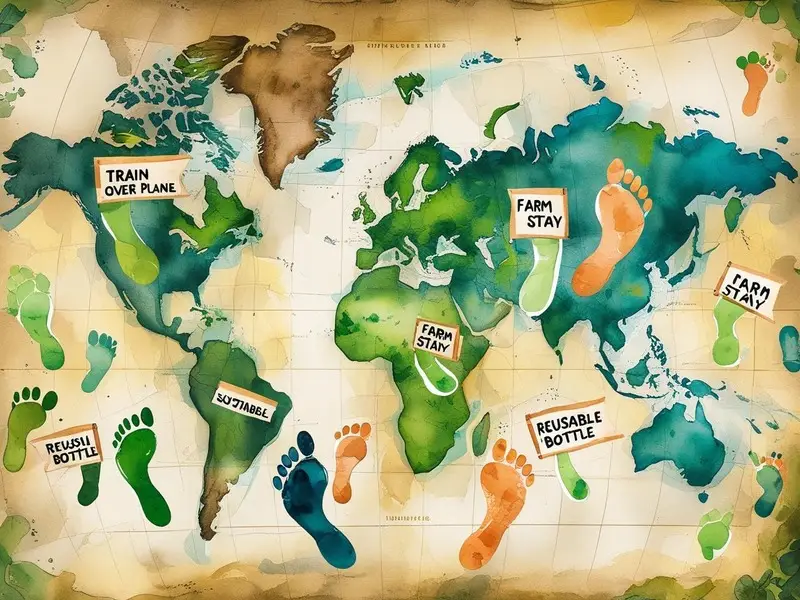In a world heavily affected by global warming and where people are becoming more aware of environmental protection, the method of travel has been the object of more attention. While going to new places and getting to know different cultures have their benefits, in some cases, tourism has become a major source of global carbon emissions—especially through flights, cruises, and some harmful activities.
Nevertheless, the earth doesn’t have to pay the price for the human’s travel. By knowing how to change your attitude and with conscious preparation, you can still see the world while you decrease your carbon footprint. This guide is fit for you no matter what the duration or place of your trip is, and it will reveal to you step by step how to make your trips environmentally friendly without losing the excitement of discovering.

The different ways you can do to lower your carbon footprint while traveling
The following are the determinants of carbon emissions from travel:
- Flying is the main contributor to the sector of air travel, accounting for at least 2.5% of the total CO2 emissions
- Cruises are very well known as heavy consumers of fuel, and their running leads to a large number of ocean pollutions
- Land transport, on the other hand, is very dependent on fossil fuels
- Accommodation and energy use include such issues as the consumption of electricity, the usage of heating and the generation of waste
The “carbon footprint” is the sum of greenhouse gas emissions over the full life cycle of the production process, activities, and consumption by an individual, thing, event, or a particular type of organization. In terms of travel, this covers not only all your flights but also all your meals and your hotel stays.
It is possible to reduce your carbon footprint in travel and still enjoy proper travel conditions.
1. Choose Low-Carbon Transportation Options
Normally, transportation accounts for the biggest carbon outlet of any trip. Here’s what you can do to cut it as much as possible:
Fly Less and Fly Direct
Aeroplanes are the most polluting source of CO2 per passenger-mile, particularly during the takeoff and landing. To make your journey more eco-friendly:
- Avoid unnecessarily long distances and save on fuel
- Select non-stop flights whenever available as this will also reduce the number of take-offs
- Travel by train or bus for short distances, especially in Europe and certain parts of Asia
- Adopt the slow travel approach which implies spending more time in one place rather than moving all over
Embrace Trains, Buses, and Shared Transport
Trains and buses produce much less CO₂ per mile than cars or planes. In Europe, Japan, and parts of the US in particular, trains are not only a greener solution but also very comfortable, scenic, and fast. Make use of:
- Public buses or intercity coaches
- Rideshare apps with carpooling options
- Bike-sharing programs in urban areas
Walking or cycling, of course, are among the greenest and most active ways of transport!
2. Be Minimalist in what you carry and be smart about it
Easier than you think – reducing your luggage weight is one of the simplest ways to lower the fuel consumption of your flight. Lighter luggage = lower emissions.
Guidelines for packing in a sustainable way:
- Carry single articles of clothing that have many uses and are of good quality instead of carrying several outfits
- Replace disposable travel items with reusable items: Water bottle Coffee cup Tote bag Stainless steel straw or utensils
- Water bottle
- Reusable bags for groceries when you go shopping.
- Eco-friendly food packaging to-go.
- Thermal travel mugs for hot beverages.
- Bring your water bottle and stainless steel/collapsible cups or glasses for events.
- Carry your utensils; many are available on the market that are easy to clean and transport.
Being green and stress-free is like going together– so that the former will not need to buy the latter.
3. Stay in Eco-Friendly Accommodations
We will choose the hotel where our overnight is a very important decision. Those in the hotel business can, however, have no such things, as they unnecessarily lose energy, produce clothes from warm cloth, produce too much food, and most importantly, use electricity.

How to Choose Sustainable Stays:
- Check for environmentally-friendly facilities such as solar energy, composting, or wind power
- By local resort booking, you will be directly contributing to the growth of the local community
- Hotels can have their own farm for fresh ingredients like vegetables and fruits, they do not produce a lot of waste, they recycle more than others or even 100% of the material and energy sources they use are sustainable.
- It’s always better to check for green, responsible, and eco-indicated priorities on the part of the hotel and then decide to book or not.
Low-Impact Guest Behavior:
- Save the water, detergent, and energy that are to be spent on awaiting guests and supply the world with extra free mints by rejecting daily linen and towel changes
- Switch off, not use lights, and unplug yourself plus other disconnected appliances
- Replace the long hot falls with short showers and reduce your utility bill by good water management
A cut in environmental loads can be caused by the most basic vertices without affecting your living conditions significantly.
4. Eat and Shop Locally
Community-based and seasonally oriented eating will go a long way to lower your food-related CO2 emissions and at the same time, it is a way of showing your support for the local people.Forget about buying bottled water that was imported and packed snacks.
One of the best ways to limit waste of food is to avoid buffets that usually generate an excessive amount of food waste.
Sustainable Souvenir Shopping:
- Purchase locally made crafts instead of mass-produced souvenirs.
- Avoid trade in animal products (like ivory, shells, or leather from endangered species).
- Do not let plastic bags and packaging rule the day.
When you choose to purchase from local businesses, not only do you reduce transport emissions – but also encourage cultural connection.
5. Offset Your Carbon Emissions
There will be a lot of greenhouse gas emissions which you, despite your best efforts, will not be able to prevent, especially when you have to be on a plane for a long time. The carbon offset programs are the solution you are looking for to achieve the balance as you will be the one to choose the projects that have the most positive impacts on the environment.
What Are Carbon Offsets?
Carbon offsets change:
- The acquisition and use of renewable energies
- Reforestation and forest conservation
- Collection of methane and other projects that are aimed at reducing emissions
How to Offset Effectively:
- Choose platforms that adhere to best practices like Gold Standard, ClimateCare, MyClimate, and Terrapass.
- Find out the amount of carbon the flight emits (most platforms have their own calculators).
- Go for the full round-trip to offset your carbon footprint (not just one leg).
While buying carbon offsets might not be the ultimate solution, it is a step that is necessary and can serve as a complement to other measures taken to lessen your travel impact.
6. Respect Nature and Local Culture
Your green travel guide should be more inclusive than just managing emissions, as it also has to cover leave-no-trace and respect for local culture and traditions and the people of every place you may visit.
Environmental Respect:
- Do not walk away from the trails when you go trekking to prevent erosion
- Don’t touch any of the corals or feed any of the animals
- It is particularly important not to exhibit noise pollution in ecosystems that are very sensitive
- As a sustainable souvenir, please refrain from picking up shells, stones or flowers
Cultural Responsibility:
- Respect local habits and customs regarding clothing, etc.
- Get to know a little bit of the local language
- It is courteous to ask permission before taking photos of people or sacred sites
- Drive cultural heritage, avoid exploitation
Sustainability is not just about the environment, but also a social and ethical commitment.
7. Share Your Green Travel Story
One strong way that can help in the spread of eco-travel is to set a good example. Share your stories to ignite the green trend and encourage others to have the same and to be more sustainable.

Tips for Sharing:
- Comment on eco-friendly hotels, tours, and transportation
- Use the right hashtags to make the post viral: #ecotravel, #sustainabletourism, #lowimpacttravel
- Write genuine reviews for environmentally friendly businesses
- Be transparent about your achievements and your failures—people appreciate authenticity
Due to the prompt outreach to your community via social media, a ripple effect of the people’s shift to sustainable consumerism may be witnessed.
Conclusion: Travel Better, Not Less
Traveling is a very fulfilling human activity that provides learning, teaching, and is an eye-opener to individuals engaged in it. Transcending the above, travel need not be at the expense of the earth’s resources.
Environmentally friendly travel isn’t about performing just the right actions – it’s about resolving to carry out these actions. Every positive action you engage in for the environment may look insignificant yet aggregate creating sustainable tourism in the end. Whether you decide to travel by train instead of taking an airplane, stay in a solar-driven hotel, or simply reject the offer of plastic cutlery, each of these steps adds to the global struggle for going green.
Next time you are going on a trip, put the question to yourself like this:
“How can I responsibly explore and make a positive impact on the environment?”
Because a rich and deep, personally meaningful journey is a measure of not only miles—but also of how thoughtful you are towards the world you’re walking in.
FAQs: Eco-Friendly Travel & Carbon Reduction
Q: What is the most eco-friendly way to travel?
A: The most eco-friendly way to travel is by train or bus because it gives out a significantly lower amount of air pollution than flying or driving. However, the greenest modes of traveling are walking and cycling.
Q: Does flying economy reduce my carbon footprint?
A: Yes, definitely. Flying in an economy class airplane translates to more passengers per flight and the carbon emissions per person as a result of this are fewer than in business or first class.
Q: Are carbon offsets really effective?
A: Carbon offsets could be a great solution if you involve them in other sustainable practices. Make sure to buy them from chosen transparent, and verified sources.
Q: How do I know if a hotel is eco-friendly?
A: The hotel’s sustainability policies, water and energy consumption efficiency, and the presence of recycling programs can give you an idea if it’s eco-friendly. Also, an eco-hotel has an eco-certification logo or a series of logos from verified environmental organizations.